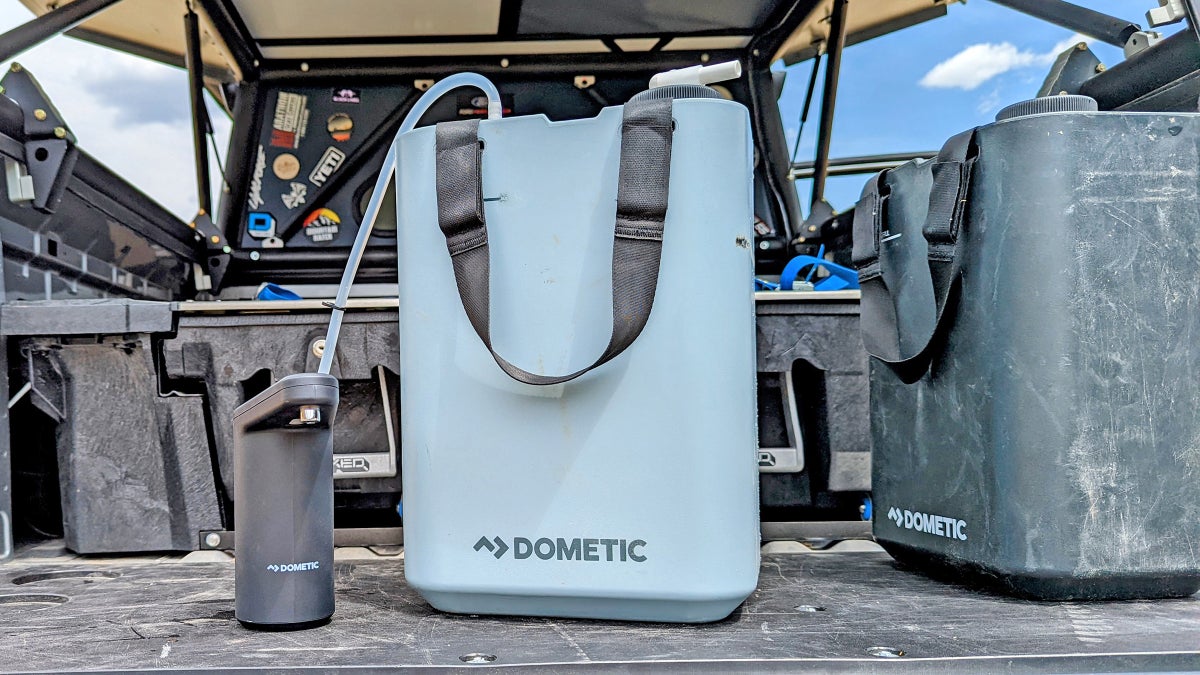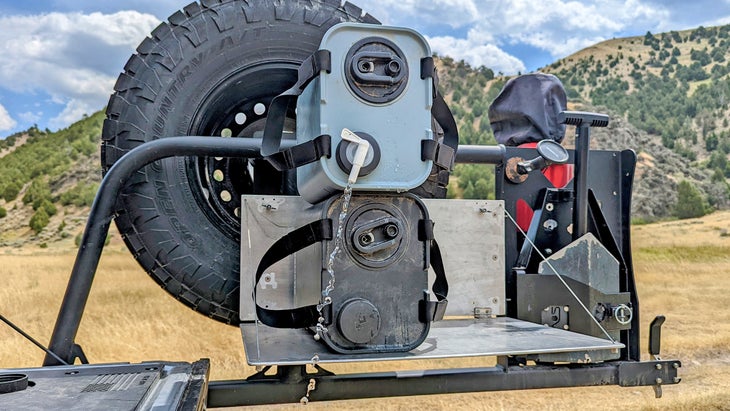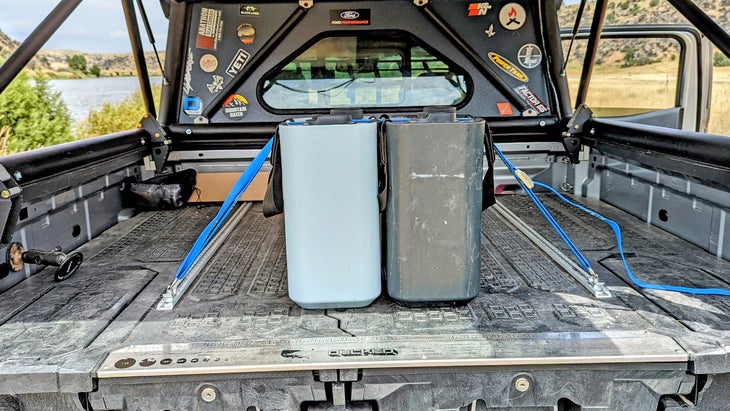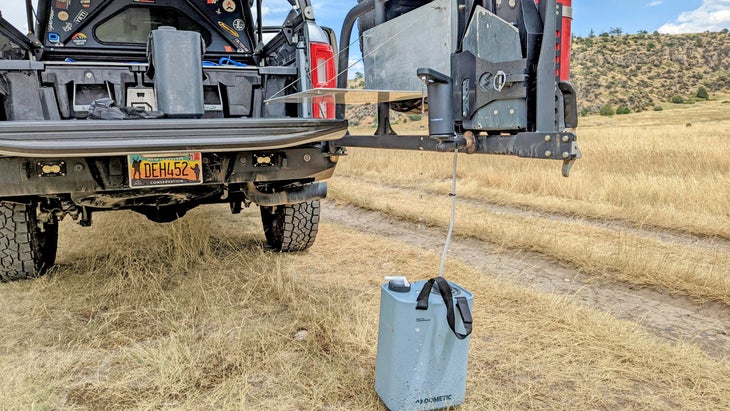
How do you carry water when you go camping? Disposable water bottles are terrible for the environment. Big water containers are difficult to pour, challenging to carry, and tough to fit into your vehicle. And, beyond providing drinking water, none of the above are optimized for common tasks like brushing teeth, cleaning dishes, or washing your hands. What if there was a better way?
That’s a question that’s been on Owen Mesdag’s mind for years. Formerly a product designer at Mountain Safety Research (MSR), he helped create surprisingly useful tools in other often overlooked categories. Mesdag created the first touchscreen-compatible, waterproof case for smartphones, in sync with the launch of the original iPhone. At MSR, he adapted a military water filter design to hydration bladders, allowing you to just suck on the hose, and filter as you drink. He once spent six months, and took two trips to Thailand, just to find the perfect tine thickness for a fork.
So he didn’t shy away from the challenge of water storage. “The problem is most liquid containers were designed for gasoline, not water,” says Mesdag.
Most of the typical water jugs you’ll find at an outdoors store are at least partially based on Jerry cans—a five-gallon metal fuel canister designed for the German army in World War Two. As that design’s utter ubiquity suggests, they’re great at providing bulk storage of liquids in a container that can be carried and poured by a single soldier. But going camping shouldn’t feel like boot camp.
Mesdag’s new job is designing friendly, accessible car camping gear for Swedish brand Dometic. There, he’s tasked with removing barriers to entry, and making the outdoors more comfortable for hardcore and casual campers alike. His new water jugs ($70) and water faucet ($100) embody that approach.
Starting with the five-gallon Jerry can archetype, Mesdag first set out to make that volume of water easier to carry. Five gallons of water weighs 42 pounds. Given that Jerry cans are designed to be carried one-handed, that’s heavy enough to be a real pain. Mesdag’s solution? Two smaller containers, each half the size of that Jerry can, fitted with comfortable carrying straps.
“You’re balanced when you walk with two of them that way,” the designer says.

But that’s not the only trick to the shape and size. Stack those two Dometic containers on their sides, and they precisely replicate the dimensions of a Jerry can. If your truck is already fitted with a Jerry can holder, you can just load the Dometic jugs into that. It’s an approach that gives buyers immediate access to a huge range of mounts, locks, and other accessories.
Those dimensions also just happen to perfectly fit behind the wheel arches in the trunk of a Subaru. So carrying the jugs will be easy, even if you don’t have a truck bristling with Jerry can mounts.
Stacked on their sides, you can simply connect the included tap to the small port on one of the container’s lid, and have enough height to easily fill a water bottle. An air valve built into the lid of the large port, and a flow limiter inserted behind that tap, facilitate a smooth flow. Those same features create what Mesdag describes as “a perfectly laminar flow,” while pouring from that small port. That means no more glugging. A handle molded into the jug’s base, right where you need it to raise it up, also helps make things easier.

That small port is 63 millimeters in diameter, with raised external threads that match the pitch and thickness of a standard Nalgene container. So you can also just screw on any filter or other accessory designed to fit one of those. The larger port is four inches in diameter—large enough that you can reach your hand inside to clean the jug. That isn’t possible with most Jerry cans or water jugs, so if one of those does ever grow mold or similar inside, you’re forced to throw it out.
In addition to the air valve, the large cap has CPC fitting, which Mesdag included to make the jug compatible with the MSR Home Emergency Water Filter (another one of his designs). If you need to grab some water from a non-potable spigot, you can just connect that filter and fill your jug without getting any drops or splashes of unfiltered water inside.
“I like to think of my water jug as a water vault,” says Mesdag. Filling it through the CPC fitting keeps your water totally safe from anything unfiltered or dirty throughout the entire duration of your camping trip.
And that CPC fitting creates other possibilities. Looking for the easiest possible way to run a sink in your camper? Connect your sink drain to one empty Dometic jug via that fitting, and add water from a full one. You’ll know the gray water tank is full when your water source runs out. And you can just lift it outside and empty it without any hassle. That’s the solution Scott Brady, the founder and publisher of Overland Journal, is using in his new camper build.
Mesdag also designed a water faucet that draws liquid from the jug through that CPC fitting. And it matches the clever attention to detail found in the jug. Powered by a rechargeable lithium battery, the faucet hides an electric water pump that moves one liter of water per minute. Tap the touch-sensitive button on the top of the faucet with a finger or elbow, and it will run for 60 seconds before shutting off. That gives you plenty of time to wash your hands or brush your teeth, without wasting water, or trying to operate a button or handle in the middle of one of those processes. Tap it again if you want to turn it off sooner.
A single battery charge is good for 150 minutes of pump operation, which should be plenty to get even a sizable group through a weekend camping trip. There’s a small LED light under the lip of the faucet to illuminate whatever you’re doing. The faucet is fitted with a magnetic base, so you can securely stick it in a convenient location. It ships with a metal puck backed with a sticky pad, perfect for connecting the faucet to a wood table or an aluminum tailgate. That puck is precisely matched to the dimensions of one corner of the jug’s lid if you want to mount your faucet there.

The pump in the faucet is self priming, and features an anti-siphon valve. So you don’t need to worry if there’s air in the water line, and you can mount the faucet lower than the jug without leaks.
Mesdag’s final trick? Smoothing out the jug’s interior doesn’t just remove places where dirt and germs can hide, it also adds volume. Even though two of the jugs fit into the same space as a Jerry can, at 11-liters in volume each, those two jugs actually hold two liters more.
Describing all these features makes the jug and faucet sound like complicated products. But while the attention Mesdag may have lavished on them is extreme, the result is the simplest possible experience for users. The jugs are made from rotomolded polyethylene, so they’re robust enough to last a lifetime. Connecting and using the faucet is completely intuitive. The whole system just works.
The post Thanks to Dometic, You’ll Have Running Water on Your Next Camping Trip appeared first on Outside Online.

